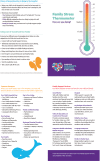Co-designed PICU Family Stress Screening and Response System to Improve Experience, Quality, and Safety
- PMID: 31321362
- PMCID: PMC6494229
- DOI: 10.1097/pq9.0000000000000145
Co-designed PICU Family Stress Screening and Response System to Improve Experience, Quality, and Safety
Abstract
Objective: Evidence for successful and sustainable models that systematically identify and address family stress in the pediatric intensive care unit (PICU) remains scarce. Using an integrated improvement science and family engagement framework, we implemented a standardized family stress screening tool and response protocol to improve family experience and reduce family crises through the timely coordination of parent support interventions.
Methods: We conducted this improvement initiative in the 12-bed PICU of a children's hospital within a large, urban academic medical center. Our team, which included 2 family advisors, adapted a validated Distress Thermometer for use in pediatric intensive care. A co-designed family stress screening tool and response protocol were iteratively tested, refined, and implemented in 2015-2017. Process and outcome measures included screening and response reliability, parent satisfaction, and security calls for distressed families.
Results: Over the 18 months, the percentage of families screened for stress increased from 0% to 100%. Among families who rated stress levels ≥5, 100% received the recommended response protocol, including family support referrals made and completed within 24 hours of an elevated stress rating. From 2015 to 2017, PICU parent satisfaction scores regarding emotional support increased from a mean score of 81.7-87.0 (P < 0.01; 95% CI). The number of security calls for distressed families decreased by 50%.
Conclusions: The successful implementation of a co-designed family stress screening tool and response protocol led to the timely coordination of parent support interventions, the improved family perception of emotional support, and reduced family crises in the PICU.
Figures




References
-
- Als LC, Nadel S, Cooper M, et al. A supported psychoeducational intervention to improve family mental health following discharge from paediatric intensive care: feasibility and pilot randomised controlled trial. BMJ Open. 2015;5:1–8. Available at http://bmjopen.bmj.com/content/5/12/e009581.abstract. Accessed September 11, 2018. - PMC - PubMed
-
- Nelson LP, Gold JI. Posttraumatic stress disorder in children and their parents following admission to the pediatric intensive care unit: a review. J Crit Care. 2018;45:149–155. - PubMed
-
- Rodriguez-Rey R, Alonso-Tapia J, Colville G. Prediction of parental posttraumatic stress, anxiety, and depression after a child’s critical hospitalization. Aust Crit Care. 2019;32:46–53. - PubMed
-
- Colville G, Pierce C. Patterns of post-traumatic stress symptoms in families after paediatric intensive care. Intensive Care Med. 2012;38:1523–1531. - PubMed
-
- Rennick JE, Morin I, Kim D, et al. Identifying children at high risk for psychological sequelae after pediatric intensive care unit hospitalization. Pediatr Crit Care Med. 2004;5:358–363. - PubMed
LinkOut - more resources
Full Text Sources
